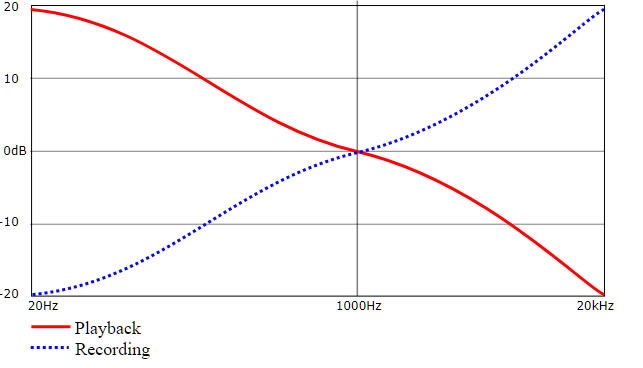- AccurateRip
- Acoustid
- AES/EBU
- AirPlay
- Amplifier
- aptX
- Audio file formats
- ASRC
- AVB
- Bit perfect jitter
- Bits: 16 or 24
- Bit perfect playback
- Bitrate
- Bluetooth
- Burn-in
- BWF
- Cables
- CDtext
- Chromecast
- Clipping
- Clock
- Codec
- Compression
- CRC
- Crossover
- Cue sheet
- DAC
- Damping
- DASH
- Digital
- Digital Room Correction
- Dither
- DLNA
- Drivers
- DoP
- DSP
- EBU R128 (loudness)
- FFT
- FireWire
- Freedb
- Gapless playback
- Generation loss
- HDMI
- Headphone listening
- Hearing
- Hires recording
- Homeplug
- I2S
- ID3
- Inter sample peak
- LDAC
- Linearity (DAC)
- Memory playback
- Music Server
- OCF
- OFC
- PCM
- Perception
- RAID
- ReplayGain
- Ripping
- RFI
- RIAA
- Router
- Sampling, up and over
- Sample Rate Conversion
- Speakers
- S/PDIF
- Storage
- Sync
- Tagging
- Toslink
- Transcoding
- UAA
- Units
- UPnP
- USB
- VST
- WiFi
- WiSA
RIAA
A question often asked on audio fora is “I connected a turntable to my amp. I have to turn up the volume substantially and if I do it sounds horrible. What am I doing wrong?”
Most of the time these people are totally new to vinyl and connect the TT (turntable) straight to a line-in of the amp.
The output of a cartridge is very low. You need an additional amp to bring it to line level.
Vinyl has its limitations, you can’t have big amplitudes (bass) and the surface noise is pretty high. The trick is to EQ the recording before cutting the master.
Lower the bass so the groove can accommodate it and amplify the treble to get a better signal to noise ratio.
This is known as the RIAA equalization.

RIAA curve for recording and playback[1]
The phono stage of an amp or a separate phono amp does both the amplification and apply the (reverse to the recording) RIAA equalization.
RIAA was implemented as a standard around 1954.
Before the time, each record company applied its own standard.
Lovers of 78 rpm recording know this.
Implementation
The RIAA is part of a phono stage in an phono amp.
Not all implementations are equal.
Stanley Lipshitz put a cat among the pigeons in the June 1979 issue of the Journal of the Audio Engineering Society with an unprecedentedly detailed examination of the circuits used to apply RIAA/IEC deemphasis. He concluded that many of these were in error as a result of incorrect design equations being applied, or because the effects of other time constants in the circuit, and/or the influence of amplifier loop gain, were ignored. The corollary was another round in the nascent objectivist/subjectivist struggle in which it was claimed that many of the disparities heard between different amplifiers were due to nothing more exotic than significant departures from flat frequency response.
Source: Stereophile [2]
Vinyl ripping
What the hell has vinyl to do on a side dedicated to computer audio?
Well if you digitize vinyl you can record the output of a phono stage.
This of course gives you signal including the the RIAA correction.
An alternative is to use a linear amplifier ( a mic amp) and apply the RIAA in software.
Software like Audacity can do RIAA correction.[3]
- RIAA equalization - Wikipedia
- Cut and Thrust: RIAA LP Equalization - Stereophile 2009
- Recording 78 rpm records - Audacity
- Guide to Converting Analog Vinyl To Digital Files Using Windows - Mitch Barnett

